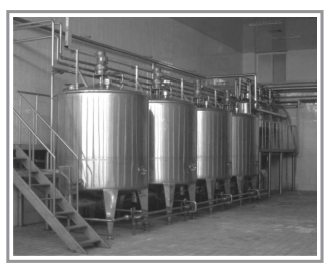$$ \text { Why does 'Swiss cheese' have big holes? } $$
The large holes in 'Swiss cheese' are due to production of a large amount of $\mathrm{CO}_2$ by a bacterium named Propionibacterium sharmanii.
What are fermentors?
For large scale production of biotechnological products, e.g., antibiotics, beverages) in industries, microbes are grown in very large vessels called fermentors or bioreactors.
 $$ \text { Fermentors } $$
$$ \text { Fermentors } $$
Name a microbe used for statin production. How do statins lower blood cholesterol level?
Statins are bioactive molecules, produced by the yeast Monascus purpureus. These bioactive molecules have been commercialised as blood-cholesterol lowering agents. It acts by competitively inhibiting the enzyme responsible for synthesis of cholesterol.
Why do we prefer to call secondary waste water treatment as biological treatment?
Secondary waste water treatment is called biological treatment because microorganisms are involved in the breakdown of organic matter in this phase of waste water treatment.
The primary effluent is passed into large aeration tanks where the organic matter in it is consumed by aerobic microbes which are later themselves digested by anaerobic bacteria and fungi in anaerobic sludge digesters.
What for nucleopolyhedro viruses are being used now a-days?
Several methods of biological control are being used in the pest management to keep the pollution-free environment and yield clean, non-toxic and good quality products for human consumption.
Baculoviruses are a group of viruses used as biological control agents that occur naturally and are specific to some insects. Most of the baculoviruses belong to the genus Nucleopolyhedro virus.
These viruses are excellent candidates for species-specific, narrow spectrum insecticidal applications. They have been shown to have no negative impacts on plants, mammals, birds fish or even on non-target insects.
This is especially desirable when beneficial insects are being conserved to aid in an overall Integrated Pest Management (IPM) Programme or when an ecologically sensitive area is being treated.